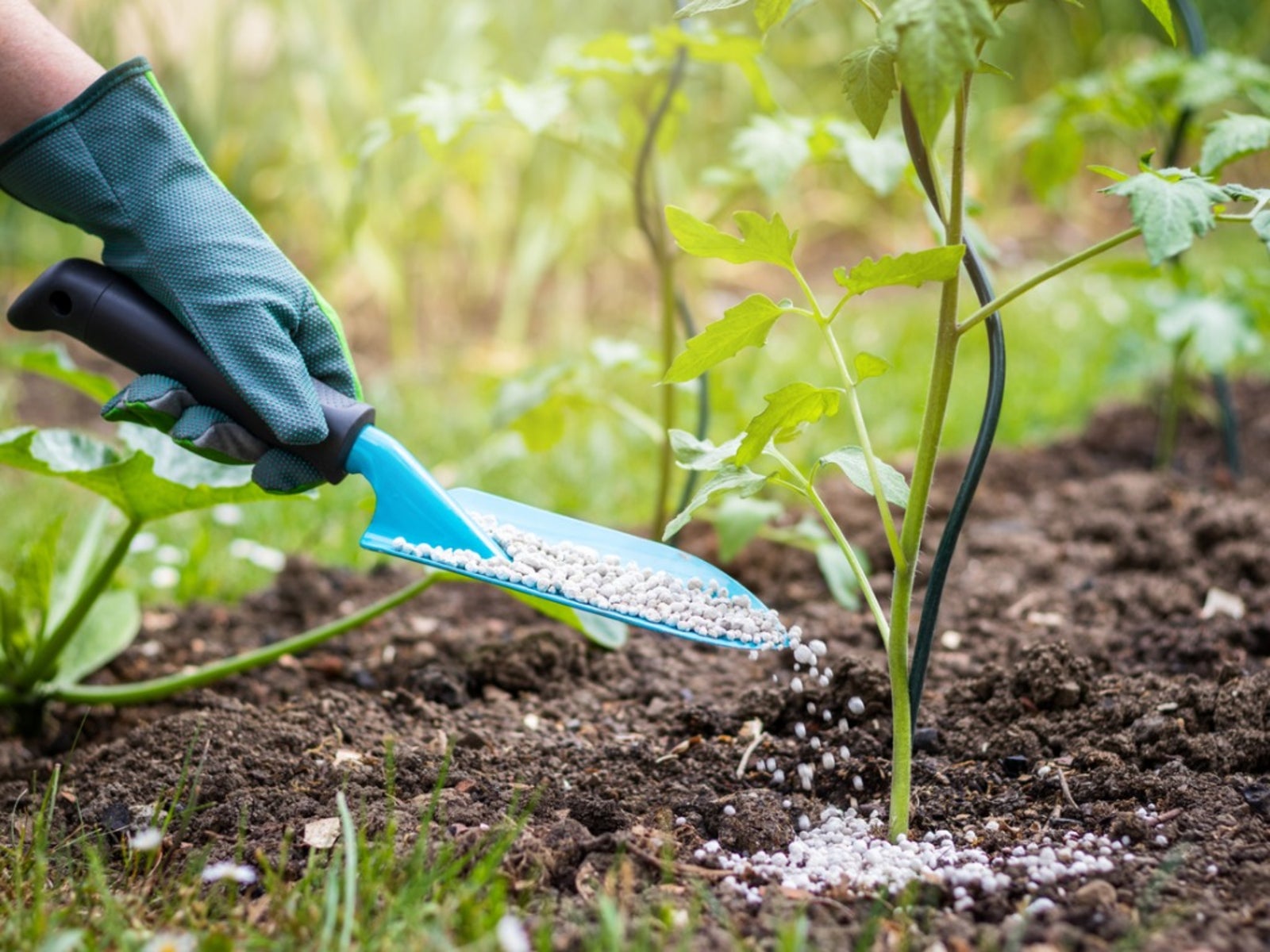Fertilizing Tomatoes: Tips For Using Tomato Plant Fertilizer


Bonnie L. Grant
Tomatoes, like many annuals, are heavy feeders and do better when provided with plenty of nutrients to grow through the season. Fertilizers, either chemical or organic, can help provide the extra nutrients that tomatoes need to grow quickly. Understanding which fertilizer to use (and when to add it) will give you the best chance of nurturing robust plants and quality fruits.
What is a good tomato fertilizer? When should you be fertilizing tomato plants? Keep reading and we will answer your questions about fertilizing tomatoes.
Tomato Nutrient Needs
Tomatoes need nitrogen, phosphorus, and potassium (often abbreviated as npk) to fuel leaf, root, and fruit development. The best tomato fertilizer should also include calcium, magnesium, and other trace elements. Tomatoes are big feeders, but high amounts of nitrogen can lead to excess production of leaves at the cost of fruit production.
Having a soil pH of 5.5-7 is ideal. It's a good idea to perform a pH test prior to the season’s planting. Amend the soil if necessary with lime at least 3 months prior to planting. The optimum soil pH will assist with availability of soluble nutrients.
Types of Tomato Fertilizer
Organic tomato fertilizer is a very popular way to feed food plants. Synthetic formulas may also be used. One of the first steps to feeding a tomato plant is to amend the soil. Well rotted manure or compost are suggested applications.
Work these into the soil to a depth of at least 6 inches (15 cm) several weeks prior to planting. This will give the amendment time to begin releasing gentle nutrients. There are water soluble foods, granular, foliar, and time release formulas available. A time release is ideal for forgetful gardeners that don’t have a regular tomato fertilizer schedule.
What is the Best Tomato Fertilizer?
Fertilizers list three numbers on the label. This indicates the ratio by weight of each of the 3 macronutrients present in the formula: nitrogen, phosphorus, and potassium. At transplant, a starter food high in phosphorus will spur cell formation, root growth, and shoot formation. Phosphorus amounts are indicated by the second number in the ratio. Potassium, the final number, helps plants uptake water and nutrients.
Sign up for the Gardening Know How newsletter today and receive a free copy of our e-book "How to Grow Delicious Tomatoes".
If your soil is correctly balanced or high in nitrogen, you should use a fertilizer that is slightly lower in nitrogen and higher in phosphorus, such as a 5-10-5, 10-20-10, or 5-10-10 mixed fertilizer. If you are slightly lacking in nitrogen, use a balanced fertilizer like 8-8-8 or 10-10-10.
If you are unable to get a soil test done, unless you have had problems in the past with sickly tomato plants, you can assume that you have a balanced soil and use the higher phosphorus tomato plant fertilizer.
When fertilizing tomato plants, be careful that you don’t use too much nitrogen - the first number in the ratio. This will result in a lush, green tomato plant with very few tomatoes. If you have experienced this problem in the past, you may even want to consider simply providing phosphorus to the plant instead of a complete fertilizer for tomatoes.
Homemade Tomato Fertilizer
There are many common organic items that will enhance growth and production in tomatoes. Wood ashes are an excellent source of potassium. Epsom salts will provide magnesium to stave off yellowing leaves. Chopped up banana peels provide a boost of potassium, as does kelp meal. Coffee grounds contain 20 percent nitrogen and are a slow release, gentle delivery of this macronutrient to fuel leaf development.
When to Fertilize Tomato Plants
In addition to soil amendment prior to planting, it's a good idea to incorporate a starter food at the same time. Work the fertilizer well into the soil and select one that is high in phosphorus such as 5-10-5. Once the first fruits are observed, feed the plant again. Foliar applications of magnesium will help reduce yellowing of leaves when the plant is in magnesium poor soil.
Additionally, a side dress of calcium nitrate several weeks after planting will help form strong cell walls in the fruit. Apply this 6 inches ( 15 cm) away from the stems to prevent root burn. Once the first fruits are being harvested, feed the plant again. Container grown plants may need to be fed more frequently due to leaching of the soil through drainage holes.
How to Fertilize Tomatoes
When fertilizing tomatoes while planting, mix the fertilizer in with the soil at the bottom on the planting hole, then place some unfertilized soil on top of this before placing the tomato plant into the hole. If raw fertilizer comes in contact with the roots of the tomato plant, it can burn the them.
When fertilizing tomato plants after the fruits have set, make sure to water first. If the tomato plant isn’t watered well before being fertilized, it can take up too much fertilizer and get burned.
After watering, spread the fertilizer on the ground starting approximately 6 inches (15 cm.) from the base of the plant. Fertilizing too close to the tomato plant can result in fertilizer running off onto the stem and burning the tomato plant.
If the fertilizer is broadcast, make sure to rinse it off the plant leaves to prevent burning. The best time to fertilize is in the evening as the sun goes down or after a rain. Container plants will benefit from a time release formula.
Looking for additional tips on growing perfect tomatoes? Download our FREE Tomato Growing Guide and learn how to grow delicious tomatoes.

Heather Rhoades founded Gardening Know How in 2007. She holds degrees from Cleveland State University and Northern Kentucky University. She is an avid gardener with a passion for community, and is a recipient of the Master Gardeners of Ohio Lifetime Achievement Award.
- Bonnie L. GrantWriter